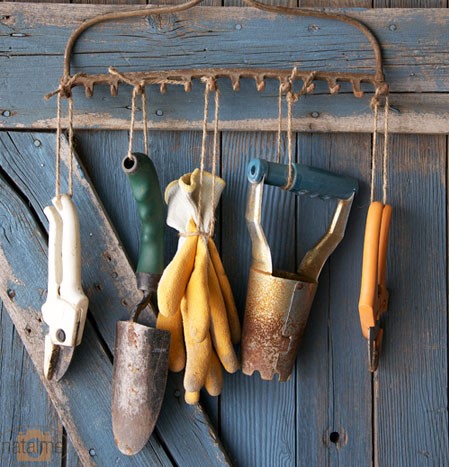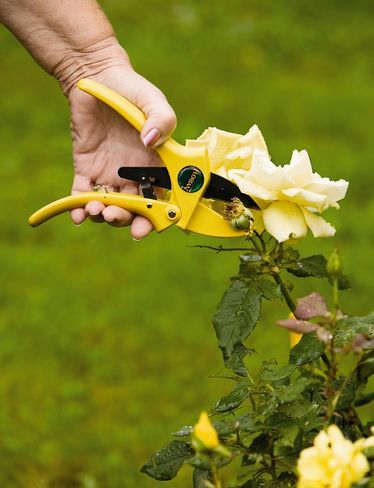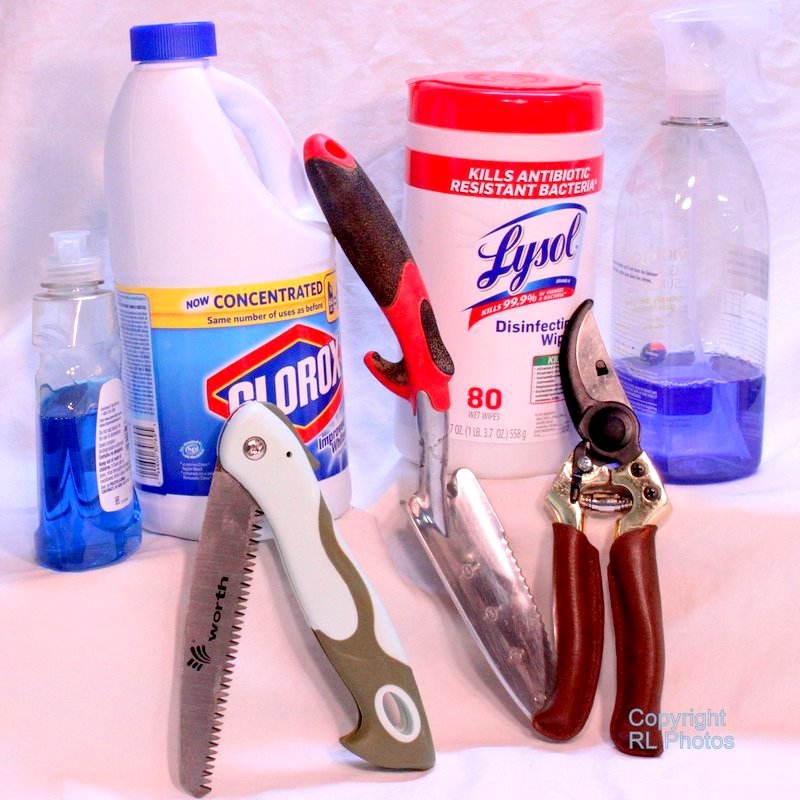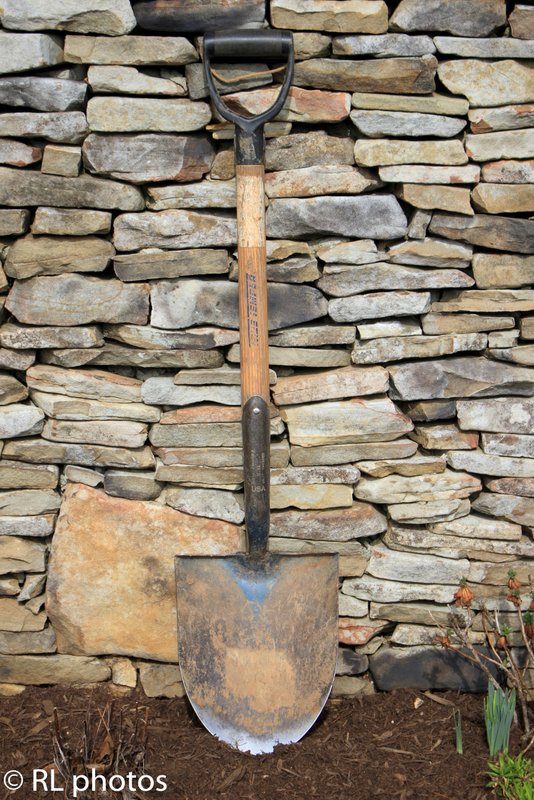Cleaning and Disinfecting Garden ToolsSteps to Take for Disease Prevention - by R. Lieber
By nature (and a biology degree) I have always been a bit of a skeptic, so new solutions were not something I jumped on board with quickly. In recent years, the advice to disinfect all of your garden tools as you are working became commonplace; but I was a bit in doubt about the "how" and "what" that was being advised. As with the antibacterial soaps that have turned out to be a bad idea, there is little information to back up the most touted remedies. Is disinfecting and cleaning really necessary? And, when it is, just what works and what is the safest, least harmful way to do it? Much of the existing research covers agricultural use where monocultures are the norm and where disease and insects can run rampant very quickly (especially true in greenhouse situations). They often require surgical grade cleanups and involve some pretty strong chemical intervention. Our gardens rarely have the same level of problems unless we have our own plant monoculture. So, what can we take home from the research out there?
This may seem a bit like asking why we need to wash our hands. Like human diseases, plant bacteria and viruses, and even microscopic pests, can be introduced into healthy plants by things we humans do in the garden. Cutting stems, bruising or breaking leaves, splashing water on leaves from the ground up - these are the main human caused disease spreading actions. Additionally, garden pests that chew on plants not only disfigure leaves, but they may cause disease as they pierce the leaves and stems of healthy plants, leaving an opening in the normal plant defenses. To add insult to injury they often pass along hitchhiking organisms picked up from an unhealthy plant. Getting rid of those bad bugs should be a priority for most of us. However, gardener cleanliness is just as important in the effort to keep our plants safe and healthy. The utmost attention to cleanliness needs to be taken when pruning and deadheading our precious plants. As a bonus, keeping our tools clean prolongs the tool's useful life. What needs cleaning and what needs disinfecting? Tools like shears, loppers, weeders, hoes, shovels and anything that contacts plant parts or carries infectious material up from the soil need frequent cleaning and disinfecting. Pots and containers used for replanting, transferring and gifting plants should always be well washed, as should trowels, weeders and so on. Careful detergent and hot water cleaning of these items will go a long way to keeping the garden healthy. All tools that cut into the stem, leaf or roots of a plant, including shrubs or trees can carry contamination past the plants natural defenses. Keeping these implements washed and decontaminated reduces unintentional spread of diseases. The one set of tools most likely to carry diseases from plant to plant are garden sheers, loppers or pruners. It is easy to carry infections from stem to stem, plant to plant as you deadhead and trim in the garden, especially when obvious signs of infection might not be apparent. If you keep your cutting tools disinfected after working on each plant you will dramatically cut down on problems. Common Household "Chemicals" that can or can't disinfect tools
When to clean the tools and how to store them Ideally after every use we should wash and clean tools, especially if we have noticed something indicating a plant infection. In reality, at least disinfect when you have finished working on one plant before you move on to the next, even when disease is not obvious. At the end of the year you should clean all tools carefully by rinsing them clean of dirt, using turpentine for sticky sap, then disinfecting, followed by oiling to prevent rust and corrosion. All of the tools should be kept off of the floor and should not be nested.
While keeping our tools germ free as possible is a big step in disease prevention, getting rid of all sources of re-infection goes a long way to a healthier garden. The best way to deal with an ongoing disease problem like powdery mildew, various leaf spots and other bacterial and viral diseases is to clean up thoroughly in fall and winter. Raking up every last piece of the diseased plants and making sure they either are composted in a very hot compost pile or tossed in the trash to be carted far, far away is one of the best and least harmful ways to control many garden problems. While you are at it, this is the best time to completely pull up any remaining unhealthy plants. Taking these hosts away and letting the harsh changes of winter sterilize the area will allow you to start fresh in the spring. Some plants have declining health after a few years where dividing is not effective, so sometimes removal and planting new is the best rejuvenation. Of course it makes for a great reason to go plant shopping, too! I cut back any perennial that has shown signs of disease including the seed heads normally left up as bird food. Rudbeckia and Echinacea in my garden usually make great natural seed sources for birds. Unfortunately for the birds, it seems to be better if I trim away all these seed heads along with leaf removal. Rudbeckia are very prone to powdery mildew, no matter what magic cure-all I have tried. The Echinacea were once infected by a single diseased plant bought on sale (it didn't look sick!). The disease is carried by a flightless mite so it is never truly eradicated without a more "nuclear" option than I am willing to undertake. I control both with lots and lots of cleanup all season long and completely cutting down the plants after the first few frosty night have induced them to go dormant. In upcoming Hands in the Dirt articles, look for more discussions on Disease Prevention and Disease Treatments where we'll discuss fungicides, insecticides and other treatments for diseases and pests in the garden. |


 I've had my fair share of garden diseases, insects and pests that arrive from outside my garden, and I don't want them to spread; but hate resorting to toxic compounds to have a healthy garden. I love the idea of prevention rather that treating the problem, too. Unfortunately, more often than not, old time remedies or the latest hyped cure-all don't prove to do what is promised. Like many gardeners, I prefer to try the safest and greenest way to deal with garden issues first before escalating to stronger methods. But how do we know what that is?
I've had my fair share of garden diseases, insects and pests that arrive from outside my garden, and I don't want them to spread; but hate resorting to toxic compounds to have a healthy garden. I love the idea of prevention rather that treating the problem, too. Unfortunately, more often than not, old time remedies or the latest hyped cure-all don't prove to do what is promised. Like many gardeners, I prefer to try the safest and greenest way to deal with garden issues first before escalating to stronger methods. But how do we know what that is? Why do we need to disinfect at all?
Why do we need to disinfect at all? There have been just a few studies done of the compounds, natural or manmade, that have disinfecting qualities appropriate to garden use. Some just don't live up to being all purpose killers of garden diseases right off the bat. These include anti-bacterial soaps and hand sanitizers (triclosan), ammonia and ammonia based cleaners, Listerine, vinegar, hydrogen peroxide, and tea tree oil. Rubbing alcohol has proven to be pretty effective but problematic because of flammability and cost effectiveness. Pine-Sol, Lysol and chlorine bleach have the best track record in true disinfection. Chlorine bleach can be diluted to 10%, but is only effective for 30 minutes or so and is very corrosive to tools and clothing as well as when skin contact is made, or the fumes inhaled. Chlorine is also phytotoxic (fancy word for plant poisoning chemical) to quite a few plants. Pine-Sol was not quite effective as bleach and Lysol. The surprising winner for both disinfecting effectiveness, eco-friendliness and cost effectiveness turned out to be one I have been using for quite some time after discovering it in the lab setting: Lysol! It has been my go-to in wipe form so it was gratifying to see the results. It is not corrosive to tools (recommended by tool makers like Fiskars) and has not been shown to be phytotoxic. That is a concern if some of your disinfectant remains on the pruners and shears just cleaned between plants.
There have been just a few studies done of the compounds, natural or manmade, that have disinfecting qualities appropriate to garden use. Some just don't live up to being all purpose killers of garden diseases right off the bat. These include anti-bacterial soaps and hand sanitizers (triclosan), ammonia and ammonia based cleaners, Listerine, vinegar, hydrogen peroxide, and tea tree oil. Rubbing alcohol has proven to be pretty effective but problematic because of flammability and cost effectiveness. Pine-Sol, Lysol and chlorine bleach have the best track record in true disinfection. Chlorine bleach can be diluted to 10%, but is only effective for 30 minutes or so and is very corrosive to tools and clothing as well as when skin contact is made, or the fumes inhaled. Chlorine is also phytotoxic (fancy word for plant poisoning chemical) to quite a few plants. Pine-Sol was not quite effective as bleach and Lysol. The surprising winner for both disinfecting effectiveness, eco-friendliness and cost effectiveness turned out to be one I have been using for quite some time after discovering it in the lab setting: Lysol! It has been my go-to in wipe form so it was gratifying to see the results. It is not corrosive to tools (recommended by tool makers like Fiskars) and has not been shown to be phytotoxic. That is a concern if some of your disinfectant remains on the pruners and shears just cleaned between plants. End of season cleanup (cleaning tools is not the only thing you need to do!)
End of season cleanup (cleaning tools is not the only thing you need to do!)